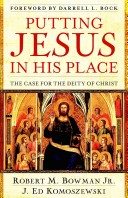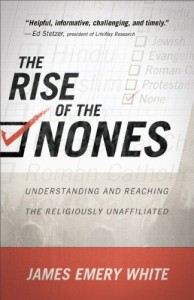Dr. Michael Gleghorn makes a case for why Christian doctrine and apologetics are important for spiritual growth and maturity.
 Just prior to beginning college, I committed my life to Christ. Naturally, as a new believer wanting to grow in my faith, I embarked upon a program of daily Bible reading. When I came to Paul’s letter to Titus in the New Testament, I was both struck and inspired by a particular command, which I found nestled among others, there in the first chapter.
Just prior to beginning college, I committed my life to Christ. Naturally, as a new believer wanting to grow in my faith, I embarked upon a program of daily Bible reading. When I came to Paul’s letter to Titus in the New Testament, I was both struck and inspired by a particular command, which I found nestled among others, there in the first chapter.
Paul reminded Titus, whom he had left on the island of Crete, that he wanted him to “straighten out what was left unfinished and appoint elders” in the local churches which had been established (Titus 1:5). After listing various spiritual and moral qualifications that an elder was to have, Paul went on to insist that he must also “hold firmly to the trustworthy message as it has been taught, so that he can encourage others by sound doctrine and refute those who oppose it” (Titus 1:9). When I first read those words, it was as if a light went on inside my head and I thought, “That’s exactly what I would like to do! I want to be able to ‘encourage others by sound doctrine and refute those who oppose it’” (Titus 1:9). Paul’s words thus encouraged me to take up, in a serious way, the study of Christian doctrine and apologetics.
But what exactly do I mean by “Christian doctrine” and “apologetics”? At its most basic level, Christian doctrine is essentially the same thing as Christian teaching. Such teaching aims at providing a logically consistent and “coherent explication of what the Christian believes.”{1} Apologetics is a bit more complicated. It comes from the Greek term, apologia, and means “defense.” It was often used in law courts in the ancient world.{2} Indeed, the book of Acts records several instances in which the Apostle Paul was called upon to “make a defense” of himself before various governing authorities, like Felix, Festus, and Agrippa (e.g., Acts 24:10; 25:8; 26:1-2).
Of course, when we’re talking about Christian apologetics, we’re concerned with “making a defense” of the truth-claims of Christianity. The Apostle Peter tells us, “Always be prepared to make a defense to any one who calls you to account for the hope that is in you, yet do it with gentleness and reverence” (1 Peter 3:15). Christian doctrine and apologetics play an important role in the life and health of the church. So please keep reading as we delve more deeply into these issues.
The Value of Christian Doctrine
Why is Christian doctrine important for the life and health of the church? The Apostle Paul told Titus that he wanted him to appoint elders in the local church who would be able to “encourage others by sound doctrine and refute those who oppose it” (Titus 1:9). The teaching of sound Christian doctrine is important for several reasons, but for now let me simply mention two. First, sound Christian doctrine helps us to learn what is true about both God and ourselves. Second, it reminds us of the right way to live in light of such truths. And both of these are essential for the life and health of the church.
First, it’s important to know what is true about God and ourselves. Indeed, our eternal destiny depends on it! Not only must we know that God is holy and righteous and will punish all sin, we must also realize that we are sinners (Numbers 14:18; Romans 3:23). But this, in itself, would lead to despair. Hence, we must also understand that God loves us and sent his Son to be the Savior of the world (John 3:16; 1 John 4:14). We need to grasp that
forgiveness and reconciliation with God are freely available to those who turn to Christ in repentance and faith (Acts 3:19; 16:31). Sound Christian doctrine is thus essential for salvation (John 14:6; Acts 4:12; 1 John 5:9-13; 2 John 1:9). Without it, true spiritual life and health is impossible.
But this does not exhaust the importance of Christian doctrine. For once we are saved through faith in Christ, God then calls us to grow up and become like his Son—and this would be exceedingly difficult apart from instruction in sound Christian doctrine. As Christian philosopher Bill Craig observes, “If we want to live correctly for Christ . . . we need to first think correctly about Christ. If your thinking is skewed and off-base, it is going to affect your life and your Christian discipleship.”{3} Indeed, the Apostle Paul contrasts Christian maturity, characterized by genuine “knowledge of the Son of God,” with spiritual immaturity, characterized by a lack of such knowledge and a proneness to being deceived (Ephesians 4:13-14).
God calls us to Christian maturity—and instruction in Christian doctrine plays an important role in our spiritual growth. But there is also a role for Christian apologetics—and we must now turn to consider that.
A Defense of Christian Apologetics
Many people question the value of Christian apologetics for the life and health of the church.{4} They contend that it’s impossible to “argue” anyone into becoming a Christian. Instead of making a defense for the truth of Christianity, we ought rather to invest our limited resources in preaching the gospel of Christ, trusting that God will open people’s hearts and draw them to himself.
Now while I certainly agree that we should be preaching the gospel, and trusting that God will use it to draw men and women to himself, this negative view of apologetics is frankly unbiblical, untrue, and shortsighted.
In the first place, such a view is unbiblical. Both Jesus and the Apostle Paul used arguments and evidence to convince their listeners of particular theological truths (Matthew 22:15-46; Acts 17:16-34). Moreover, the
Apostle Peter tells us to always be ready to “make a defense” (or offer an apologetic) to those who ask about our hope in Christ (1 Peter 3:15). A negative view of Christian apologetics thus runs counter to the teaching of
Scripture.
Second, it’s simply untrue that no one ever comes to Christ through apologetic arguments and evidence.{5} Indeed, sometimes the Holy Spirit actually uses arguments and evidence to draw people to Christ!{6} And while such people may admittedly be in the minority, they can be extremely influential in commending the faith to others, for they are often prepared to offer good reasons for believing that Christianity is really true!
Finally, a negative view of Christian apologetics is shortsighted. The great theologian J. Gresham Machen argued that we should aim to create “favorable conditions for the reception of the gospel.” Along these lines, he noted the difficulty of attempting to do evangelism once we’ve given up offering an intellectually credible case for the truth of Christianity. “We may preach with all the fervor of a reformer,” he said, “and yet succeed only in winning a straggler here and there, if we permit the whole collective thought of the nation . . . to be controlled by ideas which . . . prevent Christianity from being regarded as anything more than a harmless delusion.”{7} Machen understood that neglecting apologetics is shortsighted. For unless we offer arguments and evidence, we make it that much easier for people to simply shrug their shoulders and continue ignoring Christianity’s truth-claims.
Having now dismantled the arguments against apologetics, we’ll next consider its benefits for the life and health of the church.
The Value of Christian Apologetics
Christian apologetics is concerned to offer a robust defense for the truth of Christianity. Hence, training in Christian apologetics can be of great value for the life and health of the church. This is because such training helps to instill within believers a deep confidence that Christianity is really true. And when one becomes convinced that Christianity is really true, one is typically more likely to share one’s faith with others—and less likely to abandon the faith when confronted with various social, cultural, and intellectual pressures.
Let’s consider that first point, that when one becomes convinced of Christianity’s truth, one is more likely to share this truth with others. Many Christians admit to being hesitant about sharing their faith because they’re afraid someone will ask them a question that they are ill-prepared to answer.{8} Training in apologetics can help counteract this fear. Granted, one may still be asked a question that is difficult to answer. But apologetics training can help alleviate the fear associated with such situations by helping believers understand that good answers are available—even if they can’t remember what those answers are! To give an illustration, if I learn that there is excellent evidence that a particular drug can cure some disease, then I will be far more confident about sharing this fact with others—even if I can’t answer all their questions about how the medicine works. I may not remember exactly how it works, but I do know that there is very good evidence that it works. And knowing this, I will naturally be more confident telling others about it, even if I can’t answer all their questions about how or why.
Moreover, training in apologetics can help insulate believers from abandoning the faith, for they now know that there are good reasons to believe that Christianity is really true. Of course, most people who abandon the faith do
so for non-intellectual reasons. Still, as Paul Chamberlain observes, “A number of vocal critics who have moved from Christianity to atheism cite intellectual difficulties with Christianity” as a prime reason for quitting the faith.{9} While apologetics training can’t completely prevent such outcomes, it can make them less likely. After all, it’s far more difficult to abandon a view once you’ve become sincerely convinced of its truth.
Our Witness to the World
Over a hundred years ago, the theologian J. Gresham Machen forcefully argued that, for the faithful Christian, all of life—including the arts and sciences and every sphere of intellectual endeavor—must be humbly consecrated to the service of God.{10} Indeed, this should be true not only for every individual Christian in particular, but for the entire church in general. Our witness to the world depends on it.
Machen wrote:
Christianity must pervade not merely all nations, but . . . all of human thought. The Christian, therefore, cannot be indifferent to any branch of earnest human endeavor. It must all be brought into some relation to the gospel. It must be studied either in order to be demonstrated as false, or else in order to be made useful in advancing the Kingdom of God. . . . The Church must seek to conquer not merely every man for Christ, but also the whole of man.{11}
In this article, we’ve been considering the importance of Christian doctrine and apologetics for the life and health of the church. And clearly, Machen’s proposal cannot be effectively implemented apart from a healthy understanding of these issues on the part of the church. After all, how can “all of human thought” be brought “into some relation to the gospel” unless we first understand what the gospel is? How can views “be demonstrated as false” unless we first have some idea of what’s true—and how to reason correctly about it? How can views “be made useful in advancing the Kingdom of God” unless we first understand such views, along with how and why they can be useful in advancing God’s kingdom? If we are ever to have a hope of carrying out a project like this, in a manner that is both practically effective and faithful to our God, then sound Christian doctrine and apologetics must occupy a central role in our endeavors.
Christian doctrine and apologetics are not antithetical to the life and health of the church. They are rather of fundamental importance. Only by knowing what we believe, and why it’s really true, can we fulfill Peter’s injunction to always be ready “to make a defense” to anyone who asks about our hope in Christ (1 Peter 3:15). And only thus can we progress to true spiritual maturity, avoiding the “craftiness of men in their deceitful scheming” (Ephesians 4:13-14). So if we care about the life and health of the church—along with its witness to the world—we must encourage a healthy dose of respect for sound Christian doctrine and apologetics.
Notes
1. Molly Marshall-Green, “Doctrine,” in Holman Bible Dictionary, gen. ed. Trent C. Butler (Nashville: Holman Bible Publishers, 1991), 374.
2. Steven B. Cowan, “Introduction,” in Five Views on Apologetics, ed. Steven B. Cowan (Grand Rapids, MI: Zondervan, 2000), 8, Kindle.
3. William Lane Craig, “Foundations of Christian Doctrine (Part 1),” Reasonable Faith, October 22, 2014, accessed August 22, 2018, www.reasonablefaith.org/podcasts/defenders-podcast-series-3/s3-foundations-of-christian-doctrine/foundations-of-christian-doctrine-part-1/.
4. Many of the points made in this section are indebted to the discussion in William Lane Craig, “Foundations of Christian Doctrine (Part 2),” Reasonable Faith, October 29, 2014, accessed August 29, 2018, www.reasonablefaith.org/podcasts/defenders-podcast-series-3/s3-foundations-of-christian-doctrine/foundations-of-christian-doctrine-part-2/.
5. See, for example, the “Testimonials” section of the Reasonable Faith website, accessed August 29, 2018, www.reasonablefaith.org/testimonials.
6. William Lane Craig, Reasonable Faith: Christian Truth and Apologetics, 3rd ed. (Wheaton, IL: Crossway Books, 2008), 192.
7. J. Gresham Machen, “Christianity and Culture,” Princeton Theological Review 11 (1913): 7.
8. Indeed, entire books have been written to help believers feel better prepared for such conversations. See, for example, Mark Mittelberg, The Questions Christians Hope No One Will Ask: (With Answers) (Tyndale, 2010).
9. Paul Chamberlain, “Why People Stop Believing,” Christian Research Journal 41, no. 4:11.
10. Machen, “Christianity and Culture,” 5.
11. Ibid., 6.
©2019 Probe Ministries

 A recent book by Robert Bowman and Ed Komoszewski titled Putting Jesus in His Place is a great confidence builder for those wrestling with this key doctrine. The book offers five lines of evidence with deep roots in the biblical material. The book is organized around the acronym H.A.N.D.S. It argues that the New Testament teaches that Jesus deserves the honors only due to God, He shares the attributes that only God possesses, He is given names that can only be given to God, He performs deeds that only God can perform, and finally, He possesses a seat on the throne of God.
A recent book by Robert Bowman and Ed Komoszewski titled Putting Jesus in His Place is a great confidence builder for those wrestling with this key doctrine. The book offers five lines of evidence with deep roots in the biblical material. The book is organized around the acronym H.A.N.D.S. It argues that the New Testament teaches that Jesus deserves the honors only due to God, He shares the attributes that only God possesses, He is given names that can only be given to God, He performs deeds that only God can perform, and finally, He possesses a seat on the throne of God. During an eclipse, the heavens declare the glory of God by allowing us to see things about the sun we wouldn’t be able to observe any other way, beautiful and gloriously resplendent. Just before totality we can see “Baily’s Beads.” Only seen during an eclipse, bright “beads” appear at the edge of the moon where the sun is shining through lunar valleys, a feature of the moon’s rugged landscape. This is followed by the “diamond ring” effect, where the brightness of the sun radiates as a thin band around the circumference of the moon, and the last moments of the sun’s visibility explode like a diamond made of pure light. After the minutes of totality, the diamond ring effect appears again on the opposite side of the moon as the first rays of the sun flare brilliantly. These sky-jewelry phenomena are so outside of mankind’s control that witnessing them stirs our spirits (even on YouTube!) with the truth of Romans 1:20—”God’s invisible qualities—his eternal power and divine nature—have been clearly seen, being understood from what has been made, so that people are without excuse.”
During an eclipse, the heavens declare the glory of God by allowing us to see things about the sun we wouldn’t be able to observe any other way, beautiful and gloriously resplendent. Just before totality we can see “Baily’s Beads.” Only seen during an eclipse, bright “beads” appear at the edge of the moon where the sun is shining through lunar valleys, a feature of the moon’s rugged landscape. This is followed by the “diamond ring” effect, where the brightness of the sun radiates as a thin band around the circumference of the moon, and the last moments of the sun’s visibility explode like a diamond made of pure light. After the minutes of totality, the diamond ring effect appears again on the opposite side of the moon as the first rays of the sun flare brilliantly. These sky-jewelry phenomena are so outside of mankind’s control that witnessing them stirs our spirits (even on YouTube!) with the truth of Romans 1:20—”God’s invisible qualities—his eternal power and divine nature—have been clearly seen, being understood from what has been made, so that people are without excuse.” A total solar eclipse offers so much more, though, than Baily’s Beads and the Diamond Ring. At the moment of totality, the pinkish arc of the sun’s chromosphere (the part of the sun’s atmosphere just above the surface) suddenly “turns on” as if an unseen hand flips a switch. I knew God is very fond of pink because of how He paints glorious sunrises and sunsets in Earth’s skies, but those fortunate enough to see a total eclipse can see how He radiates pinkness from the sun itself! The heavens declare the glory of God!
A total solar eclipse offers so much more, though, than Baily’s Beads and the Diamond Ring. At the moment of totality, the pinkish arc of the sun’s chromosphere (the part of the sun’s atmosphere just above the surface) suddenly “turns on” as if an unseen hand flips a switch. I knew God is very fond of pink because of how He paints glorious sunrises and sunsets in Earth’s skies, but those fortunate enough to see a total eclipse can see how He radiates pinkness from the sun itself! The heavens declare the glory of God! For the few minutes of totality, the naked eye can see the sun’s lovely corona (Latin for crown) streaming out from the sun. We can’t see the corona except during an eclipse because looking straight at the sun for even a few seconds causes eye damage, and because the sun’s ball of fire overwhelms the (visually) fragile corona. This is another way that an eclipse allows us to see how the heavens declare the glory of God.
For the few minutes of totality, the naked eye can see the sun’s lovely corona (Latin for crown) streaming out from the sun. We can’t see the corona except during an eclipse because looking straight at the sun for even a few seconds causes eye damage, and because the sun’s ball of fire overwhelms the (visually) fragile corona. This is another way that an eclipse allows us to see how the heavens declare the glory of God.
 What made the Romans such a formidable force? Discipline and adaptability. Being able to march long distances and maneuver across a variety of terrain. Timing and distance determine the victor of any confrontation. To do this, they needed shoes that were durable and able to grip the ground firmly.
What made the Romans such a formidable force? Discipline and adaptability. Being able to march long distances and maneuver across a variety of terrain. Timing and distance determine the victor of any confrontation. To do this, they needed shoes that were durable and able to grip the ground firmly. We are also told to take up the Shield of Faith (Ephesians 6:16) to extinguish the flaming arrows of the evil one. The favored shield in the time Ephesians was written was the Roman scutum, a large shield that protected most of the soldier’s body, enabling the Romans to protect both themselves and each other in tight formations without sacrificing their defense when fighting in looser formations. Most deaths in ancient battles occurred after, during, and after a rout. Therefore projectiles were used to disrupt and to instill fear before the two sides met in melee. Standing firm against hails of projectiles was key to surviving the battle.
We are also told to take up the Shield of Faith (Ephesians 6:16) to extinguish the flaming arrows of the evil one. The favored shield in the time Ephesians was written was the Roman scutum, a large shield that protected most of the soldier’s body, enabling the Romans to protect both themselves and each other in tight formations without sacrificing their defense when fighting in looser formations. Most deaths in ancient battles occurred after, during, and after a rout. Therefore projectiles were used to disrupt and to instill fear before the two sides met in melee. Standing firm against hails of projectiles was key to surviving the battle. Finally, Ephesians 6:17 refers to the Sword of the Spirit, or the word of God. In conjunction with the scutum was the gladius, a short sword primarily used for thrusting and short cuts. It was the legionary’s primary weapon. After throwing their pila (specialized javelins) to disrupt the enemy formation, the Romans drew their swords and closed the distance to engage in hand-to-hand fighting. Their armor and discipline enabled them to weather the brutal melee far better than their opponents. Ideally, this caused the enemy to rout.
Finally, Ephesians 6:17 refers to the Sword of the Spirit, or the word of God. In conjunction with the scutum was the gladius, a short sword primarily used for thrusting and short cuts. It was the legionary’s primary weapon. After throwing their pila (specialized javelins) to disrupt the enemy formation, the Romans drew their swords and closed the distance to engage in hand-to-hand fighting. Their armor and discipline enabled them to weather the brutal melee far better than their opponents. Ideally, this caused the enemy to rout.